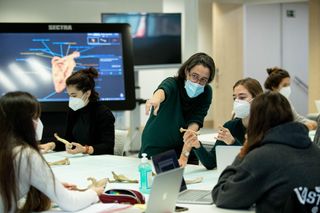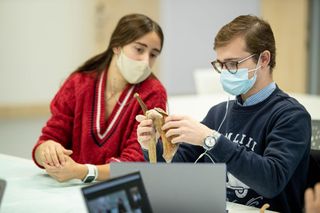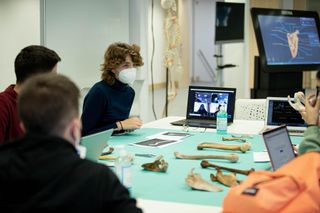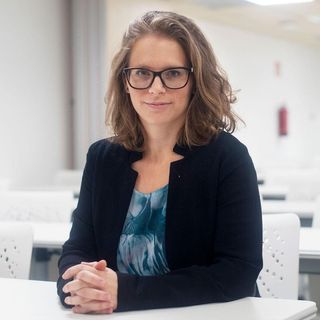- Dovetailing with the start of this academic year, the Faculty of Medicine at the UVic-UCC has launched a MIR (Resident Medical Intern) Exam Preparation Programme for all students in its Bachelor’s in Medicine
- “We want students to connect with the exam early and deeply enough so they gradually adapt to the examination technique”, says Josep Arimany, President of the Foundation of Advanced Studies in Health Sciences (FESS) and one of the driving forces behind the programme
In June 2019, 6,800 new doctors graduated in Spain after spending the previous six years training at the more than 50 faculties of Medicine around the country. However, the pathway for these budding doctors to work in their profession is not over yet. In fact, as soon as they finish the last exam in their degree programme, they enter a period of intense study lasting almost seven months to prepare for the MIR (Resident Medical Intern) exam, which is offered in January of every year. At the last edition of the exam, 12,162 aspirants sat for it (between those who had just graduated in Spain and abroad and those who are taking the exam again to improve their scores) in the hopes of being awarded one of the 7,152 places available. Securing a place allows the candidate to join a Spanish healthcare centre as a resident physician and undergo approximately six years of residency before finally concluding their training period. Three years from now, the list of aspirants will include the first graduating class from the Faculty of Medicine at the UVic-UCC.
“After a great deal of effort, years of studying at the university and months of exclusively studying for this exam, on a single day the doctors sit for an exam that will have a profound impact on their professional future”

On the long road to becoming a doctor, the MIR exam is a crucial turning point. “After a great deal of effort, years of studying at the university and months of exclusively studying for this test, on a single day the doctors sit for an exam that will have a profound impact on their professional future and their place in the world of clinical practice”, says Josep Arimany, president of the Foundation of Advanced Studies in Health Sciences (FESS), the entity in charge of the Faculty of Medicine at the Universitat de Vic – Universitat Central de Catalunya (UVic-UCC). Arimany recalls that “not only are a major percentage of candidates left without a residency, only some of those that do secure one, usually those with the highest scores, end up being able to choose the speciality they want to study and the centre where they want to do it”. For this reason, Arimany says, “this exam is a vital time in the careers of all future doctors, and it is expected for many students sitting for the exams to be nervous, tired and stressed out”.
The analysis of clinical cases as the point of departure
Bearing this situation in mind, the Faculty of Medicine at the UVic-UCC has just launched a MIR Exam Preparation Programme for all students in its Bachelor’s degree, spanning from the first through the sixth year. The programme is coordinated by Irene Veganzones and has begun this academic year, 2020-2021, dovetailing with the beginning of the fourth year of the Medicine degree in the faculty. This pioneering initiative fits in perfectly with the faculty’s teaching model, which revolves around analysing clinical cases. Along with the prevalence of these practical and simulation activities, “this approach helps students put themselves in the shoes of the doctors they will later become and to interpret the key information in order to arrive at a sound diagnosis”, says Ramon Pujol, Dean of the Faculty.
“The essence of the MIR exam is changing, and it is drawing closer to the Faculty’s teaching model, which largely revolves around analysing clinical cases”
In recent years, the essence of the MIR exam has been evolving along the same lines: “it is including more and more questions focused on analysing clinical cases and values the candidates’ ability to analyse them and to interpret or detect information in them more than the strictly rote questions which had dominated the test in the past”, adds Irene Veganzones. Currently, around 75% of the questions on the MIR are geared at analysing clinical cases.

Bearing the MIR in mind throughout the entire degree
The convergence of all these factors laid the groundwork for spearheading the MIR Exam Preparation Programme. First, says Josep Arimany, “the approach of the MIR is increasingly similar to one of the cornerstones of the teaching model in our faculty, so it makes all the sense in the world to take advantage of this similarity”. On the other hand, he says, “if we know that practically all our students will end up taking the exam (95% of Medicine graduates in Spain want to work in medical care and therefore have to take it), it would be totally illogical to go through the six years of the Bachelor’s degree ignoring this reality, especially if bearing it in mind in no way harms but actually benefits the future doctors’ training”. Ramon Pujol adds that “only the form of the question differs between the assessment system in the faculty and the questions on the MIR, because in the specialisation exam they are much more specific”. According to the dean, “the content required and the objective of the questions are the same: to make the student think about what they would do if they were dealing with a real patient”, meaning that “there is a real connection between the two models, and this gives us an edge”.
“If we know that almost all our students will end up taking the MIR, it would be totally illogical to go through the six years of the Bachelor’s degree ignoring this reality, especially if bearing it in mind in no way harms but actually benefits the future doctors’ training”
In addition to contributing to the students’ preparation for the exam, another purpose of the programme is for the students to reach the exam without feeling overly stressed. In this sense, Veganzones provides two essential pieces of information that all students have in mind: in the last edition, 1.6 candidates sat for the exam for every 1 place available, and 90% of their final score resulted from that one day, as their academic record only counts for 10%. For this reason, says the programme coordinator, the months preceding the MIR are “a time full of tension and emotional stress for the majority of candidates”. In this sense, she explains, “we want to ensure that our students are not having such a harsh experience and can sit for the exam calmly and confidently”.

Preparatory seminars and adaptation to the exams
The professionals who are developing the programme are working with two essential cornerstones: first, the faculty’s multiple choice tests will gradually be adapted so they are made using a methodology that is much more similar to the MIR’s format, “so that students are used to the kinds of questions and the reasoning they have to use when they sit for it”, Veganzones explains.
“We want to make sure that passing the MIR is not such a harsh experience for our students and they can sit for the exam calmly and confidently”
Secondly, they will practice the exam technique throughout their degree programme, much more intensively as they get closer to the sixth year. They will work with real questions from the MIR related to the subject they are studying at the time. According to Veganzones, “in this way the students will see how that topic is tested on the MIR, and we’ll determine each student’s individual weaknesses and help them overcome them”.
This approach “will not only make them better prepared when they reach the end of their degree programme, it will also give them a greater sense of security and self-confidence, which is vital for this exam”. Furthermore, the doctor and professor also concludes that “it will hone their anamnesis skills and their ability to choose the key information in order to reach the diagnosis and decide on the best way to proceed in real clinical cases”.

Josep Arimany: “The essence of the MIR is quite similar to the teaching model in our faculty, so it makes all the sense in the world to take advantage of this similarity”
The Foundation of Advanced Studies in Health Sciences (FESS) is the entity in charge of the Faculty of Medicine at the UVic-UCC. Its president, Josep Arimany, holds a PhD in Medicine from the UAB with a specialisation in medical-surgical dermatology, venereology and legal and forensic medicine. He is also the first lieutenant mayor of Vic and a councillor of the University and the City of Knowledge. Since the faculty was founded, he has been one of the leading voices and driving forces behind the MIR Exam Preparation Programme, which has been launched this year.
Why did the Faculty of Medicine decide to implement a programme like this one, which is unique and integrated into the degree programme?
We know that the vast majority of our graduates will want to work in medical care, and the only possible way to access it and be able to work at a hospital, primary care or social-healthcare is by passing the specialisation exam, which is and has long been the MIR exam. Except for those who choose to work in research, management or teaching in the medical profession, all the others will have to take a test to gain access to their speciality. In this context, as soon as the plans for the Faculty of Medicine started to take shape, we were certain that one of our missions had to be a commitment to students’ overall training not only as they pursue their Bachelor’s degrees but also afterwards to help them join the job market. Furthermore, the essence of the MIR exam is also quite similar to the teaching model in our faculty, so it makes all the sense in the world to take advantage of this similarity.
How does this model benefit students’ preparation for the exam?
Many universities introduce questions from the MIR exam in classes, but there are no committees on access to specialised training, which remain exclusively in the hands of private academies. We want to get involved in preparing students for the MIR just like baccalaureate schools get involved in preparing their students for their university entrance exams in all classes throughout the entire year. Therefore, students have a preparation which is up on the latest developments and changes in the MIR: we are the ones who worry about staying abreast of the test and knowing how it is evolving so that we can then adapt the preparation programme to these changes.
But some people say that specialised academies should prepare students for the MIR, not university faculties...
It’s true that it’s quite common to think that the universities should limit themselves to preparing students to be good doctors, and then after that the academies should train them to do well on the exam. But they aren’t mutually exclusive. The graduates of the UVic-UCC will still have to go to academies, or at least we strongly recommend that they do, to review concepts involving short-term memory during the months prior to the MIR exam. But with the integral training they will have received during their degree programme, they will be better equipped to answer the questions which are resolved with the exam technique, most of which are asked in the form of a clinical case.

Irene Veganzones: “Practising the MIR technique throughout the degree programme will give students a greater sense of security and self-confidence when they take the exam”.
Irene Veganzones’ background fits in perfectly with the requirements of a person who will coordinate a programme to prepare students for their medical specialisation, such as the one that the Faculty of Medicine has launched. In addition to serving as a rural family physician in Sarrià de Ter (Girona), she also studied Medicine at the Universitat de Barcelona - Bellvitge, specialised in family and community medicine in Manresa and has worked for seven years as a tutor and professor at the Acadèmia AMIR, which prepares students to take the access exam for specialised training.
Why did you decide to take on this challenge?
I firmly believe in the pedagogical model in the UVic-UCC Faculty of Medicine because it is strongly geared towards students’ integral education, and this is the essence of family and community medicine, my speciality. Furthermore, it is a very generalist faculty which focuses on ensuring that students are familiar with all sides of the practice of medicine so they can decide which one fits them the best. Finally, right now it is the only university which has focused on creating a MIR Exam Preparation Programme.
Why is the MIR exam so daunting?
Currently, 90% of the final qualifying score comes from the MIR exam and only 10% from the students’ marks in their degree programme. Therefore, the reality is that even if they have passed six years in the faculty and earned good marks, what will determine the final score that will allow them to choose their place is their score on the MIR exam. Furthermore, there are seven months between university graduation and the exam. During this time, not only is the MIR your end goal, no matter how well you deal with it you need the emotional support of the people around you to pass it, and this is where we need to be.
What does your vision as a family physician in a rural environment bring to the faculty’s teaching model?
Students have to be taught that most patients are not in hospitals but are in primary care and in geriatric residences, among other places. Therefore, we have to teach our students how to treat and deal with patients in these settings. Furthermore, it is important for the students not to have hospital-centred but more open training, with a view to community care and patient-centred medicine. This is actually dictated by the pedagogical model in the faculty, and I definitely identify with it.